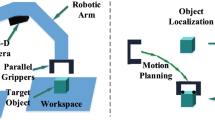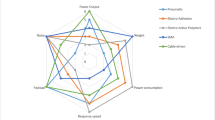Abstract
Grasp planning is crucial for many robotic applications such as object manipulation and object transport. Planning stable grasps is a challenging problem. Many parameters such as object geometry, hand geometry and kinematics, hand-object contacts have to be considered, making the space of grasps too large to be exhaustively searched. This paper presents a general approach for planning grasps on 3D objects based on hand-object geometric fitting. Our key idea is to build a contact score map on a 3D object’s voxelization, and apply this score map and a hand’s kinematic parameters to find a set of target contacts on the object surface. Guided by these target contacts, we find grasps with a high quality measure by iteratively adjusting the hand pose and joint angles to fit the hand’s instantaneous geometric shape with the object’s fixed shape, during which the fitting process is speeded up by taking advantage of the discrete volumetric space. We demonstrate the effectiveness of our grasp planning approach on 3D objects of various shapes, poses, and sizes, as well as hand models with different kinematics. A comparison with two state-of-the-art approaches shows that our approach can generate grasps that are more likely to be stable, especially for objects with complex shapes.





















Similar content being viewed by others
Notes
Regularity indicates if a polygon/polyhedron has all the same qualitative angles and all the edges of similar length (regular), or not (irregular). We normalize the regularity value within range (0,1].
In the signed distance transform map, empty, partial, and full voxels are assigned positive, zero, and negative distance values, respectively.
References
Amor, H.B., Heumer, G., Jung, B., Vitzthum, A.: Grasp synthesis from low-dimensional probabilistic grasp models. Comput. Anim. Virtual Worlds 19(3–4), 445–454 (2008)
Attene, M., Falcidieno, B., Spagnuolo, M.: Hierarchical mesh segmentation based on fitting primitives. Vis. Comput. 22(3), 181–193 (2006)
Aydin, Y., Nakajima, M.: Database guided computer animation of human grasping using forward and inverse kinematics. Comput. Graph. 23(1), 145–154 (1999)
Berenson, D., Diankov, R., Nishiwaki, K., Kagami, S., Kuffner, J.: Grasp planning in complex scenes. In: IEEE-RAS International Conference on Humanoid Robots, pp. 42–48 (2007)
Bohg, J., Morales, A., Asfour, T., Kragic, D.: Data-driven grasp synthesis—a survey. IEEE Trans. Robot. 30(2), 289–309 (2014)
Chalmeta, R., Hurtado, F., Sacristán, V., Saumell, M.: Measuring regularity of convex polygons. Comput. Aided Des. 45(2), 93–104 (2013)
Ciocarlie, M.T., Allen, P.K.: Hand posture subspaces for dexterous robotic grasping. Int. J. Robot. Res. 28(7), 851–867 (2009)
Ding, L., Ding, X., Fang, C.: 3D face sparse reconstruction based on local linear fitting. Vis. Comput. 30(2), 189–200 (2014)
Goldfeder, C., Allen, P.K., Lackner, C., Pelossof, R.: Grasp planning via decomposition trees. In: IEEE International Conference on Robotics and Automation, pp. 4679–4684 (2007)
Güngör, C., Kurt, M.: Improving visual perception of augmented reality on mobile devices with 3D red–cyan glasses. In: the IEEE 22nd Signal Processing and Communications Applications Conference, pp. 1706–1709 (2014)
Huebner, K., Ruthotto, S., Kragic, D.: Minimum volume bounding box decomposition for shape approximation in robot grasping. In: IEEE International Conference on Robotics and Automation, pp. 1628–1633 (2008)
Kim, J., Iwamoto, K., Kuffner, J.J., Ota, Y., Pollard, N.S.: Physically based grasp quality evaluation under pose uncertainty. IEEE Trans. Robot. 29(6), 1424–1439 (2013)
Kry, P.G., Pai, D.K.: Interaction capture and synthesis. ACM Trans. Graph. (SIGGRAPH) 25(3), 872–880 (2006)
Kyota, F., Saito, S.: Fast grasp synthesis for various shaped objects. Comput. Graph. Forum (Eurographics) 31(2), 765–774 (2012)
Lau, M., Dev, K., Shi, W., Dorsey, J., Rushmeier, H.: Tactile mesh saliency. ACM Trans. Graph. (SIGGRAPH) 35(4), 52:1–52:11 (2016)
Li, Y., Fu, J.L., Pollard, N.S.: Data-driven grasp synthesis using shape matching and task-based pruning. IEEE Trans. Vis. Comput. Graph. 13(4), 732–747 (2007)
Li, Y., Saut, J.P., Pettré, J., Sahbani, A., Bidaud, P., Multon, F.: Fast grasp planning by using cord geometry to find grasping points. In: IEEE International Conference on Robotics and Automation, pp. 3265–3270 (2013)
Miller, A.T., Allen, P.K.: GraspIt! A versatile simulator for robotic grasping. IEEE Robot. Autom. Mag. 11(4), 110–122 (2004)
Miller, A.T., Knoop, S., Christensen, H.I., Allen, P.K.: Automatic grasp planning using shape primitives. In: IEEE International Conference on Robotics and Automation, pp. 1824–1829 (2003)
Nooruddin, F.S., Turk, G.: Simplification and repair of polygonal models using volumetric techniques. IEEE Trans. Vis. Comput. Graph. 9(2), 191–205 (2003)
Park, Y.C., Starr, G.P.: Grasp synthesis of polygonal objects using a three-fingered robot hand. Int. J. Robot. Res. 11(3), 163–184 (1992)
Pollard, N.S., Zordan, V.B.: Physically based grasping control from example. In: ACM SIGGRAPH/Eurographics Symposium on Computer Animation, pp. 311–318 (2005)
Przybylski, M., Asfour, T., Dillmann, R.: Unions of balls for shape approximation in robot grasping. In: IEEE/RSJ International Conference on Intelligent Robots and Systems, pp. 1592–1599 (2010)
Rimon, E., Burdick, J.: On force and form closure for multiple finger grasps. In: IEEE International Conference on Robotics and Automation, pp. 1795–1800 (1996)
Roa, M.A., Suárez, R.: Grasp quality measures: review and performance. Auton. Robots 38(1), 65–88 (2015)
Rosales, C., Ros, L., Porta, J.M., Suárez, R.: Synthesizing grasp configurations with specified contact regions. Int. J. Robot. Res. 30(4), 431–443 (2011)
Sahbani, A., El-Khoury, S., Bidaud, P.: An overview of 3D object grasp synthesis algorithms. Robot. Auton. Syst. 60(3), 326–336 (2012)
Shen, C.H., Fu, H., Chen, K., Hu, S.M.: Structure recovery by part assembly. ACM Trans. Graph. (SIGGRAPH Asia) 31(6), 180:1–180:12 (2012)
Ye, Y., Liu, C.K.: Synthesis of detailed hand manipulations using contact sampling. ACM Trans. Graph. (SIGGRAPH) 31(4), 41:1–41:10 (2012)
Zhao, W., Zhang, J., Min, J., Chai, J.: Robust realtime physics-based motion control for human grasping. ACM Trans. Graph. (SIGGRAPH Asia) 32(6), 207:1–207:12 (2013)
Zhou, Q., Panetta, J., Zorin, D.: Worst-case structural analysis. ACM Trans. Graph. (SIGGRAPH) 32(4), 137:1–137:12 (2013)
Acknowledgments
This work is supported in part by Anhui Provincial Natural Science Foundation (1508085QF122), National Natural Science Foundation of China (61403357, 61672482, 11526212), and the One Hundred Talent Project of the Chinese Academy of Sciences.
Author information
Authors and Affiliations
Corresponding author
Electronic supplementary material
Below is the link to the electronic supplementary material.
Rights and permissions
About this article
Cite this article
Song, P., Fu, Z. & Liu, L. Grasp planning via hand-object geometric fitting. Vis Comput 34, 257–270 (2018). https://doi.org/10.1007/s00371-016-1333-x
Published:
Issue Date:
DOI: https://doi.org/10.1007/s00371-016-1333-x




